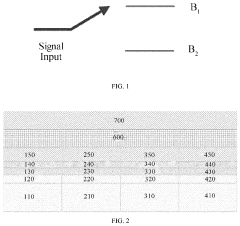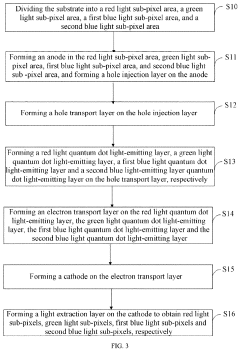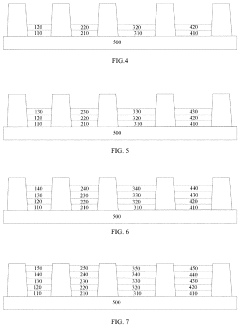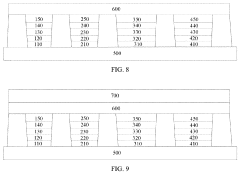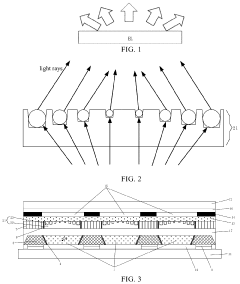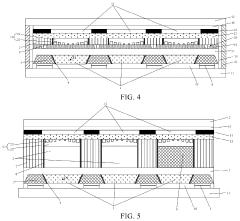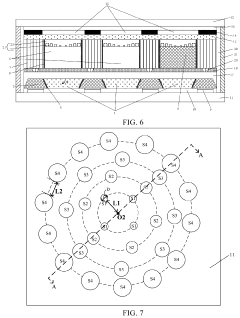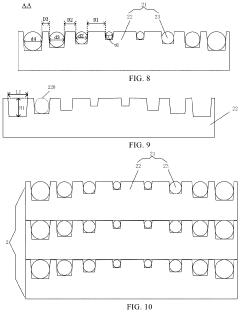QLED Displays: Revolutionizing the Home Entertainment Experience
QLED Technology Evolution
QLED technology has undergone a remarkable evolution since its inception, revolutionizing the home entertainment experience. The journey began with the development of quantum dots, nanoscale semiconductor particles that emit light of specific wavelengths when excited. These quantum dots were initially used to enhance the color performance of traditional LCD displays.
The first generation of QLED displays, introduced in the mid-2010s, utilized quantum dots in a film layer placed in front of the LED backlight. This configuration significantly improved color accuracy and brightness compared to conventional LCD screens. However, these early QLEDs still relied on LCD technology for light modulation, limiting their contrast ratios and viewing angles.
As research progressed, manufacturers focused on refining quantum dot materials and their integration into display panels. The second generation of QLED displays saw improvements in quantum dot efficiency and stability, leading to enhanced color volume and longer lifespan of the displays. This period also marked the beginning of efforts to reduce the reliance on LCD technology for light control.
The third generation of QLED displays, emerging in the late 2010s, introduced innovations in quantum dot placement and excitation methods. Some manufacturers began experimenting with direct quantum dot LED emitters, moving away from the film-based approach. This shift aimed to achieve better control over individual pixels and improve overall picture quality.
Recent advancements have focused on developing self-emissive QLED displays, often referred to as QD-OLED or QNED (Quantum Nano Emitting Diode) technology. These displays combine the color performance of quantum dots with the deep blacks and wide viewing angles of OLED technology. By eliminating the need for a separate backlight and LCD layer, self-emissive QLEDs promise to deliver superior contrast ratios and energy efficiency.
The ongoing evolution of QLED technology continues to push the boundaries of display performance. Current research efforts are directed towards improving quantum dot efficiency, reducing production costs, and exploring new materials and structures for quantum dot emitters. Additionally, there is a growing focus on developing quantum dot displays for flexible and transparent applications, potentially expanding the range of use cases for QLED technology beyond traditional flat-panel displays.
As QLED technology matures, it is increasingly challenging the dominance of OLED in the high-end display market. The continuous improvements in color accuracy, brightness, and energy efficiency are making QLED displays an attractive option for consumers seeking premium home entertainment experiences. The technology's evolution is expected to continue, with future generations of QLED displays promising even more immersive and lifelike visual experiences.
Market Demand Analysis
The market demand for QLED displays in the home entertainment sector has been experiencing significant growth in recent years. This surge is primarily driven by consumers' increasing desire for high-quality, immersive viewing experiences in their homes. As people spend more time at home for both work and leisure, the demand for superior display technology has intensified.
QLED technology offers several advantages that align with consumer preferences, including enhanced color accuracy, brightness, and contrast ratios. These features contribute to a more lifelike and engaging visual experience, making QLED displays particularly attractive for movie enthusiasts, gamers, and sports fans. The technology's ability to deliver vibrant colors and deep blacks even in well-lit rooms has further expanded its appeal to a broader consumer base.
The global QLED TV market has shown robust growth, with major manufacturers reporting increased sales and market share. This trend is expected to continue as more consumers upgrade their home entertainment systems. The COVID-19 pandemic has also played a role in accelerating this market growth, as lockdowns and social distancing measures led to increased investment in home entertainment technologies.
In terms of market size, the QLED display segment has been steadily capturing a larger portion of the overall TV market. This growth is particularly pronounced in the premium and large-screen TV segments, where consumers are more willing to invest in advanced display technologies. The market has also seen a gradual decrease in the average selling price of QLED TVs, making the technology more accessible to a wider range of consumers.
Looking at regional trends, North America and Asia-Pacific have emerged as key markets for QLED displays, with Europe following closely behind. Developing markets in Latin America and Africa are also showing increasing interest in this technology, albeit at a slower adoption rate due to price sensitivity.
The gaming industry has become a significant driver of QLED display demand. Gamers appreciate the technology's low input lag, high refresh rates, and superior color reproduction, which enhance their gaming experience. This has led to the development of QLED monitors specifically designed for gaming, further expanding the market reach of this technology.
As consumers become more environmentally conscious, the energy efficiency of QLED displays compared to some other technologies has become an additional selling point. This aligns with the growing trend of eco-friendly consumer electronics and may influence purchasing decisions in the future.
Technical Challenges
QLED (Quantum Dot Light Emitting Diode) display technology has made significant strides in recent years, offering enhanced color reproduction, brightness, and energy efficiency. However, several technical challenges persist in the development and widespread adoption of QLED displays for home entertainment systems.
One of the primary challenges facing QLED technology is the stability and longevity of quantum dots. These nanocrystals are susceptible to degradation when exposed to oxygen, moisture, and high temperatures. This degradation can lead to color shifts and reduced brightness over time, impacting the overall lifespan and performance of QLED displays. Researchers are actively working on developing more robust encapsulation methods and exploring alternative materials to enhance the durability of quantum dots.
Another significant hurdle is achieving uniform quantum dot distribution across large display areas. Inconsistent distribution can result in color variations and reduced image quality, particularly in larger screen sizes. Manufacturers are investing in advanced deposition techniques and exploring new manufacturing processes to ensure homogeneous quantum dot layers, which is crucial for maintaining consistent picture quality across the entire display surface.
The production of blue light-emitting quantum dots remains a technical challenge. While red and green quantum dots have been successfully commercialized, efficient and stable blue quantum dots are still in development. The creation of high-quality blue quantum dots is essential for achieving a wider color gamut and more accurate color reproduction in QLED displays. This limitation has led to the use of blue LED backlights in current QLED TVs, which can impact energy efficiency and color accuracy.
Heat management is another critical issue in QLED displays. The high brightness levels achieved by these displays can generate significant heat, potentially affecting the stability and performance of the quantum dots. Developing effective thermal management solutions without compromising the slim profile of modern displays is an ongoing challenge for engineers and designers.
Furthermore, the cost-effective production of QLED displays at scale remains a hurdle. While the technology offers superior performance in many aspects, the manufacturing processes for quantum dots and their integration into display panels are still more complex and expensive compared to traditional LED-LCD or OLED technologies. Reducing production costs while maintaining high quality and performance standards is crucial for wider market adoption.
Lastly, achieving true emissive QLED displays, where each pixel is self-illuminating, is a long-term goal that faces significant technical barriers. Current QLED TVs still rely on LED backlighting, limiting their ability to achieve perfect black levels and infinite contrast ratios. Overcoming this challenge would allow QLED technology to compete more directly with OLED displays in terms of picture quality and energy efficiency.
Current QLED Solutions
01 QLED display technology for enhanced visual experience
QLED (Quantum Dot Light Emitting Diode) technology is used in home entertainment systems to provide superior color accuracy, brightness, and contrast. This technology enhances the overall viewing experience by offering a wider color gamut and improved picture quality compared to traditional LED displays.- QLED display technology for enhanced viewing experience: QLED (Quantum Dot Light Emitting Diode) technology is used in home entertainment displays to provide superior color accuracy, brightness, and contrast. This technology enhances the overall viewing experience by offering wider color gamut, deeper blacks, and improved energy efficiency compared to traditional LED displays.
- Integration of smart features in QLED home entertainment systems: Modern QLED displays incorporate smart features such as voice control, AI-powered content recommendations, and seamless connectivity with other smart home devices. These features enhance user interaction and provide a more personalized entertainment experience.
- Immersive audio solutions for QLED home theaters: Advanced audio technologies are integrated with QLED displays to create immersive home theater experiences. These may include surround sound systems, object-based audio, and room calibration technologies to optimize sound quality based on the viewing environment.
- Content optimization and upscaling for QLED displays: Algorithms and processing technologies are developed to optimize and upscale content for QLED displays, ensuring that lower resolution content looks crisp and detailed on high-resolution QLED screens. This includes HDR processing, motion smoothing, and AI-based image enhancement techniques.
- Ergonomic design and installation of QLED home entertainment systems: Innovations in the physical design and installation of QLED displays focus on enhancing the overall aesthetics and integration within home environments. This includes slim profiles, cable management solutions, and flexible mounting options to improve the visual appeal and functionality of the home entertainment setup.
02 Integration of smart features in home entertainment systems
Modern home entertainment systems incorporate smart features such as voice control, AI-powered content recommendations, and seamless connectivity with other smart home devices. These features enhance user interaction and provide a more personalized entertainment experience.Expand Specific Solutions03 Immersive audio technologies for home theaters
Advanced audio technologies, such as surround sound systems and object-based audio formats, are integrated into home entertainment setups to create a more immersive viewing experience. These technologies enhance spatial audio perception and complement the visual experience provided by QLED displays.Expand Specific Solutions04 Content management and streaming capabilities
Home entertainment systems with QLED displays often include advanced content management and streaming capabilities. These features allow users to access a wide range of content from various sources, including streaming services, local media servers, and cloud storage, enhancing the overall entertainment experience.Expand Specific Solutions05 Ergonomic design and user interface for home entertainment systems
QLED-based home entertainment systems incorporate ergonomic designs and intuitive user interfaces to enhance user experience. This includes features such as customizable layouts, easy-to-use remote controls, and seamless integration with mobile devices for effortless control and content sharing.Expand Specific Solutions
Key Industry Players
QLED displays are revolutionizing the home entertainment experience, with the market currently in a growth phase. The global QLED market is expanding rapidly, driven by increasing demand for high-quality visual experiences. Technologically, QLED displays are maturing, with key players like Samsung Electronics, TCL, and BOE Technology Group leading innovation. These companies are investing heavily in R&D to enhance color accuracy, brightness, and energy efficiency. While QLED technology is well-established, ongoing advancements by firms such as Sharp, Huawei, and VIZIO are pushing the boundaries of display performance. The competitive landscape is intensifying as more companies enter the market, fostering innovation and driving down costs for consumers.
BOE Technology Group Co., Ltd.
TCL China Star Optoelectronics Technology Co., Ltd.
Core QLED Innovations
- A display device comprising a plurality of pixels, each including a red light sub-pixel, a green light sub-pixel, a first blue light sub-pixel, and a second blue light sub-pixel, where the first blue light sub-pixel is configured to emit light at high brightness and the second blue light sub-pixel is configured to emit light at low brightness, with the first blue light sub-pixel having high efficiency and the second blue light sub-pixel having a long lifetime, allowing for independent control based on brightness requirements.
- A display panel design featuring light emitting units with scattering components, where scattering particles are arranged in a matrix with particle sizes and distances correlated to increase light output, and refractive indexes varying along the light exiting direction to converge light rays, combined with quantum-dot luminescent layers and color converting units for improved light emission.
Environmental Impact
The environmental impact of QLED displays is a crucial consideration in the evolving landscape of home entertainment technology. These displays offer significant advantages in terms of energy efficiency compared to traditional LCD and OLED technologies. QLED screens consume less power during operation, particularly when displaying bright content, which translates to reduced energy consumption in households and lower carbon footprints over the lifetime of the device.
Manufacturing processes for QLED displays have also been optimized to minimize environmental impact. The quantum dot technology at the core of QLED displays uses fewer rare earth materials compared to other display technologies, reducing the strain on limited natural resources. Additionally, the production of QLED panels generally requires less energy and generates fewer harmful byproducts than the manufacture of OLED panels.
The longevity of QLED displays contributes positively to their environmental profile. With superior resistance to burn-in and longer overall lifespans, QLED TVs need to be replaced less frequently, reducing electronic waste. This durability also means that the environmental cost of production and disposal is spread over a longer period of use, improving the overall ecological footprint of the technology.
However, the environmental impact of QLED displays is not without challenges. The disposal and recycling of these devices at the end of their life cycle present unique difficulties due to the presence of quantum dots. While quantum dots are not inherently toxic, proper handling and recycling procedures must be developed and implemented to prevent potential environmental contamination.
The industry is actively working on improving the sustainability of QLED technology. Research is ongoing to develop more eco-friendly quantum dot materials and to enhance the recyclability of QLED components. Manufacturers are also investing in take-back programs and exploring circular economy models to ensure responsible disposal and maximize the recovery of valuable materials from end-of-life displays.
As consumer awareness of environmental issues grows, the eco-friendliness of QLED displays may become a significant factor in purchasing decisions. This trend is likely to drive further innovations in sustainable manufacturing practices and energy-efficient designs, potentially cementing QLED technology's position as a leader in environmentally responsible home entertainment solutions.
Consumer Experience
QLED displays have revolutionized the home entertainment experience, offering consumers unprecedented visual quality and immersive viewing. These displays utilize quantum dot technology to produce vibrant colors, deep blacks, and enhanced brightness, resulting in a more lifelike and engaging picture.
One of the most significant improvements QLED technology brings to consumers is its ability to deliver a wider color gamut. This means that viewers can experience a broader range of colors, with more accurate and nuanced shades than traditional LED displays. The result is a more realistic and captivating visual experience, particularly noticeable when watching nature documentaries, sports events, or high-quality films.
QLED displays also excel in brightness, allowing for better visibility in well-lit rooms. This feature addresses a common consumer complaint about traditional displays becoming difficult to see in bright environments. The enhanced brightness of QLED screens ensures that viewers can enjoy their content without the need to dim lights or close curtains, providing greater flexibility in how and when they use their home entertainment systems.
Another key advantage for consumers is the improved contrast ratio offered by QLED technology. The ability to produce deeper blacks alongside brighter whites creates a more dynamic image with greater depth and detail. This enhanced contrast is particularly beneficial for viewers who enjoy cinematic experiences at home, as it helps to recreate the visual impact of a movie theater.
QLED displays also offer improved viewing angles compared to many other display technologies. This means that the picture quality remains consistent even when viewed from off-center positions, making these displays ideal for larger living spaces or when entertaining groups. Consumers no longer need to fight for the "best seat" in the room to enjoy optimal picture quality.
Energy efficiency is another consumer-friendly aspect of QLED technology. Despite their superior brightness and color performance, QLED displays are relatively energy-efficient, which can lead to lower electricity bills for consumers over time. This combination of improved performance and energy efficiency makes QLED an attractive option for environmentally conscious consumers.
Lastly, QLED displays often come with smart features and connectivity options that enhance the overall user experience. Integration with voice assistants, streaming services, and smart home systems allows consumers to seamlessly control their entertainment experience and integrate their display into their broader home ecosystem.
